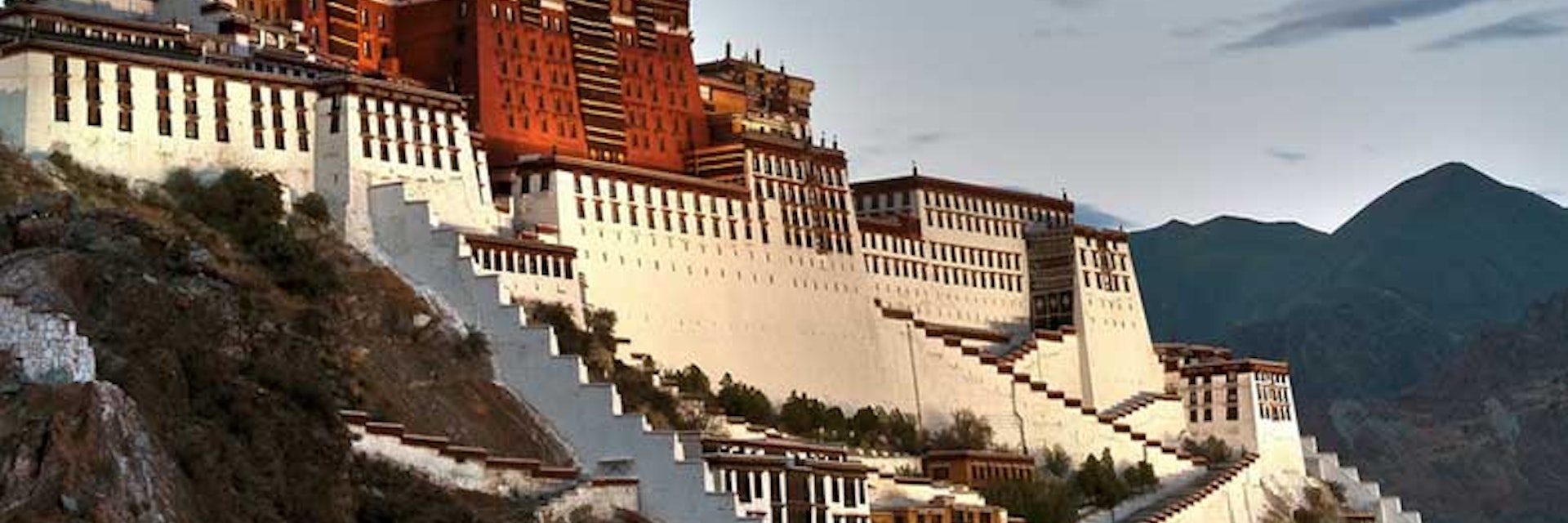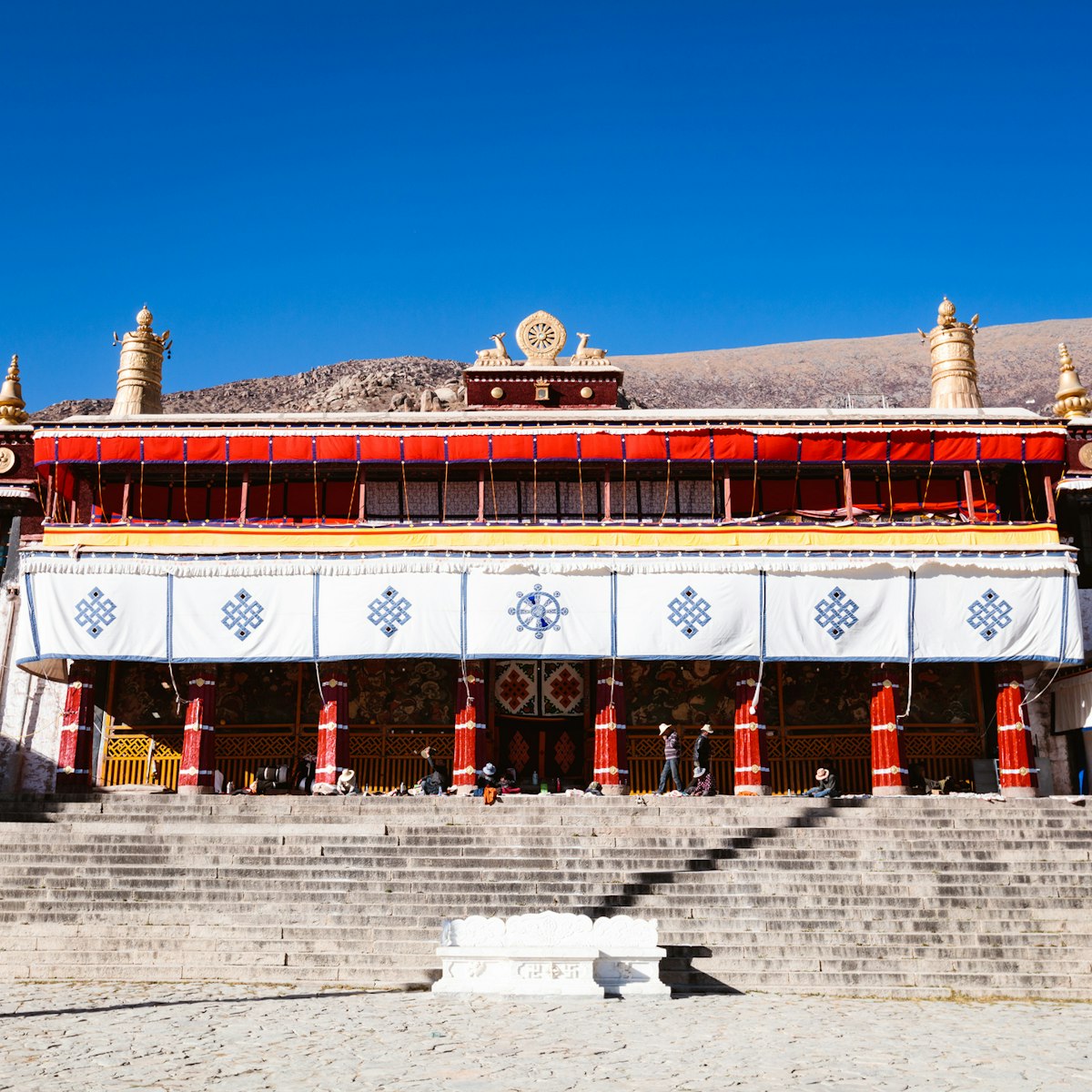You start the tour of the main Potala building from the top and descend through the bowels of the building to exit on the ground floor. The gilded buddhas, intricate mandalas and towering funeral stupas you pass en route rank as the highlights of the Potala.
Third Floor
On the 3rd floor, the first room is the Chapel of Jampa (Jamkhang), which contains an exquisite image of Jampa (Maitreya, or the Future Buddha) commissioned by the eighth Dalai Lama; it stands opposite the eighth Dalai Lama’s throne. To the left of the Jampa statue, in the corner, is a wooden Kalachakra mandala. The walls are stacked with the collected works of Tsongkhapa (founder of the Gelugpa order) and the fifth Dalai Lama. The chapel was damaged in a fire (caused by an electrical fault) in 1984 and many valuable thangkas (religious paintings) were lost.
Next, the Chapel of Three-Dimensional Mandalas (Loilang Khang) houses spectacular jewel-encrusted 18th-century mandalas of the three principal yidam (Tantric deities) of the Gelugpa order. These are essentially three-dimensional versions of the mandalas you see painted on thangkas everywhere in Tibet and act as meditation maps for the mind.
The Chapel of the Victory over the Three Worlds (Sasum Namgyal) houses a library and displays of Manchu texts. The main statue in the corner is a golden thousand-armed Chenresig, while the main central thangka is of the Manchu Chinese emperor Qianlong dressed in monk’s robes, with accompanying inscriptions in Tibetan, Chinese, Mongolian and Manchurian.
Next, the Chapel of Immortal Happiness (Chimey Dedan Kyil) was once the residence of the sixth Dalai Lama, Tsangyang Gyatso, whose throne remains; it is now dedicated to Tsepame, the Buddha of Longevity, who sits by the window.
In the northwestern corner is the Lama Lhakhang and the golden tomb of the Seventh Dalai Lama (Serdung Tashi Obar Khang), constructed in 1757 and encased in half a tonne of gold. To the right stands a half-hidden statue of Kalsang Gyatso, the seventh Dalai Lama.
Also in the northwestern corner, steps lead up into the small but important Chapel of Arya Lokeshvara (Phagpa Lhakhang). It is said that this is one of the few corners of the Potala that dates from the time of Songtsen Gampo’s 7th-century palace. It is the most sacred of the Potala’s chapels, and the sandalwood image of Arya Lokeshvara inside is the most revered image housed in the Potala. The statue is accompanied on the left by the seventh Dalai Lama and Tsongkhapa, and on the right by the fifth, eighth and ninth Dalai Lamas. Relics include stone footprints of Guru Rinpoche and Tsongkhapa.
The towering, jewel-encrusted tomb of the Eighth Dalai Lama dates from 1805 and is more than 9m tall. Pilgrims are blessed here with the hat of the eighth Dalai Lama. The equally impressive tomb of the Ninth Dalai Lama was under renovation in 2018.
Second Floor
The first of the chapels you come to on the 2nd floor is the Chapel of Kalachakra (Dukhor Lhakhang), also known as the Wheel of Time. It is noted for its stunning three-dimensional mandala, which is more than 6m in diameter and finely detailed with more than 170 statues.
In the Chapel of the Nine Buddhas of Longevity (Tsepak Lhakhang), look for the murals by the left-hand window if you can get a monk to lift the cloth – the left-hand side depicts Thangtong Gyalpo and his celebrated bridge (now destroyed) over the Yarlung Tsangpo near Chushul. The images of coracle rafts halfway up the wall add an intimate touch. Murals by the right-hand window depict the construction of the Potala. There are also nine statues of Tsepame here, as well as green and white Drölma (Tara, a female bodhisattva).
Passing the closed Chapel of Sakyamuni (Zegya Lhakhang), continue to the northwestern corner, where you’ll find a small corridor that leads to King Songtsen Gampo’s Meditation Chamber (Chogyal Drupuk), which, along with the Chapel of Arya Lokeshvara on the 3rd floor, is one of the oldest rooms in the Potala. The most important statue is of Songtsen Gampo himself, to the left of the pillar. To the left is his minister Tonmi Sambhota (said to have invented the Tibetan script) and to the right are his Chinese and Nepali wives. A statue of the king’s Tibetan wife, Mongsa Tricham (the only one to bear a son), is in a cabinet by the door. The fifth Dalai Lama lurks behind (and also on) the central pillar. Also here is Gar Tsongtsen, the Tibetan prime minister (and Songtsen Gampo's right-hand man), who travelled to the Tang court to escort Princess Wencheng back to Lhasa. Queues for this chapel can be long.
The last three rooms are all linked and are chock-a-block full of 3000 pieces of priceless statuary, many donated by a Khampa businessman in 1995.
The 1st floor has been closed to visitors for years and is unlikely to reopen soon.
Ground Floor
As you round the steps on the ground floor, enter the beautiful assembly hall, the largest hall in the Potala and its physical centre. Note the fine carved pillar heads. The large throne that dominates the far end of the hall was the throne of the sixth Dalai Lama. Four important chapels frame the hall.
The first chapel on this floor is the Chapel of Lamrim. Lamrim means ‘the graduated path’ and refers to the stages that mark the path to enlightenment. The central figure in the chapel is Tsongkhapa, with whom lamrim texts are usually associated. Outside the chapel, to the left, a fine mural depicts the Forbidden City, commemorating the fifth Dalai Lama’s visit to the court of Emperor Shunzhi in 1652. Murals depict the tent camps used by the court on its journey across Tibet.
The next chapel, the long Rigzin Lhakhang, is dedicated to eight Indian teachers who brought various Tantric practices and rituals to Tibet. The central figure is a silver statue of Guru Rinpoche (one of the eight), who is flanked by his consorts Mandarava and Yeshe Tsogyel (with a turquoise headdress), as well as statues of the eight teachers to the left and further statues on the right of the guru in the eight manifestations known as the Guru Tsengye.
In the west wing of the assembly hall is one of the highlights of the Potala, the awe-inspiring Chapel of the Dalai Lamas’ Tombs (Serdung Zamling Gyenjikhang). The hall is dominated by the huge 12.6m-high chörten of the great fifth Dalai Lama, gilded with some 3.7 tonnes of gold. Flanking it are two smaller chörtens containing the 10th and 12th Dalai Lamas, who both died as children. Richly embossed, the chörtens represent the concentrated wealth of an entire nation. One of the precious stones is a pearl said to have been discovered in an elephant’s brain and thus, in a wonderful piece of understatement, ‘considered a rarity’. Eight other chörtens represent the eight major events in the life of the Buddha.
The last chapel is the Chapel of the Holy Born (Trungrab Lhakhang). First, in the corner, is the statue and chörten of the 11th Dalai Lama, who died at the age of 17. There are also statues of the eight medicine buddhas with their characteristic blue hair, a central golden Sakyamuni and the fifth Dalai Lama (silver), and then Chenresig, Songtsen Gampo, Dromtönpa (founder of the Kadampa order) and the first four Dalai Lamas.




